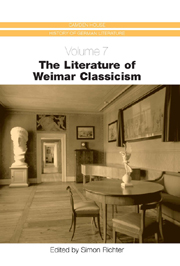Book contents
- Frontmatter
- Contents
- List of Illustrations
- Preface and Acknowledgments
- Conventions, Editions, and Abbreviations
- Introduction
- What is Classicism?
- Antiquity and Weimar Classicism
- The Correspondents' Noncorrespondence: Goethe, Schiller and the Briefwechsel
- Johann Gottfried Herder: The Weimar Classic Back of the (City)Church
- Drama and Theatrical Practice in Weimar Classicism
- German Classical Poetry
- The Novel in Weimar Classicism: Symbolic Form and Symbolic Pregnance
- German Women Writers and Classicism
- Weimar Classicism as Visual Culture
- The Irrelevance of Aesthetics and the De-Theorizing of the Self in “Classical” Weimar
- Goethe's “Classical” Science
- The Political Context of Weimar Classicism
- Bibliography
- Notes on the Contributors
- Index
The Irrelevance of Aesthetics and the De-Theorizing of the Self in “Classical” Weimar
Published online by Cambridge University Press: 05 February 2013
- Frontmatter
- Contents
- List of Illustrations
- Preface and Acknowledgments
- Conventions, Editions, and Abbreviations
- Introduction
- What is Classicism?
- Antiquity and Weimar Classicism
- The Correspondents' Noncorrespondence: Goethe, Schiller and the Briefwechsel
- Johann Gottfried Herder: The Weimar Classic Back of the (City)Church
- Drama and Theatrical Practice in Weimar Classicism
- German Classical Poetry
- The Novel in Weimar Classicism: Symbolic Form and Symbolic Pregnance
- German Women Writers and Classicism
- Weimar Classicism as Visual Culture
- The Irrelevance of Aesthetics and the De-Theorizing of the Self in “Classical” Weimar
- Goethe's “Classical” Science
- The Political Context of Weimar Classicism
- Bibliography
- Notes on the Contributors
- Index
Summary
In 1750, in the first paragraph of his Aesthetica, Frankfurt professor Alexander Gottlieb Baumgarten (1714–62) defines this brand-new intellectual discipline as “scientia cognitionis sensitivae” (the science of sensate knowledge). But unfortunately — at least for those who value neatness in history — most of the major thinkers who follow (Kant being the notable exception) either forget or neglect or simply discard this definition, concentrating instead on a pair of important, but subordinate concepts in Baumgarten's system — art and beauty — which are understood henceforward as the true content of “aesthetics.” Once this deetymologizing move has been made (aistheta, in Greek, are simply things perceived by the physical senses), the historical situation is also muddied, and the brand-new discipline is henceforth regarded as an age-old discipline, traceable at least as far back as Plato and Aristotle.
Needless to say, there are possibilities for confusion here, as well as for development; but the one possibility that is definitely excluded is that “aesthetics” should cohere as a single scientific discipline with a well-defined scope. (Do art and beauty even really belong together as objects of study?) This essay will, in fact, suggest that aesthetics is best understood not as an area of inquiry in the first place, but as a specific cultural project in eighteenth- and nineteenth-century Europe. For the time being, however, we can get a feel for what aesthetics does by considering the various issues it raises.
With respect to art, the opposition between imitative and expressive theories (traced back to the supposed founding instances of Aristotle and pseudo-Longinus) becomes increasingly important toward the end of the eighteenth century.
- Type
- Chapter
- Information
- The Literature of Weimar Classicism , pp. 295 - 322Publisher: Boydell & BrewerPrint publication year: 2005



